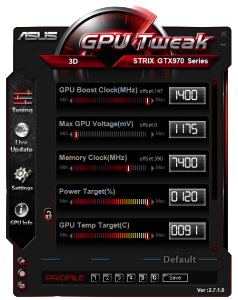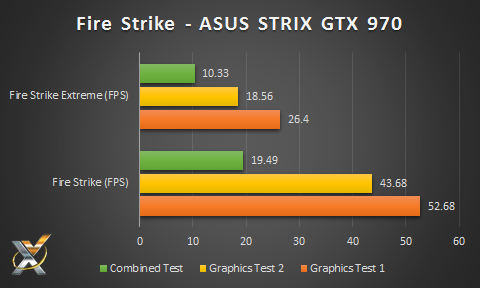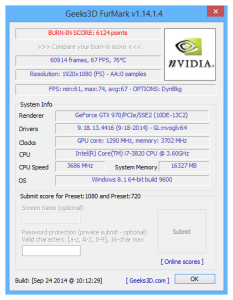OVERCLOCKING AND BENCHMARKS
While this card already has a fairly decent factory overclock, we know that Maxwell is extremely power efficient and runs very cool. The Strix has upgraded cooling, thermal and electrical components so we should be able to push it even further with a little tweaking.
OVERCLOCKING WITH ASUS GPUTWEAK
GPUTweak is a GPU monitori ng and overclocking utility that is bundled with ASUS graphics cards. While it is built to be used with ASUS GPUs, it is also compatible with virtually any nVidia or AMD graphics card, however certain features may be unavailable. The software also provides features like profiling, monitor refresh rate overclocking, and most recently a beta for Twitch streaming was made available.
ng and overclocking utility that is bundled with ASUS graphics cards. While it is built to be used with ASUS GPUs, it is also compatible with virtually any nVidia or AMD graphics card, however certain features may be unavailable. The software also provides features like profiling, monitor refresh rate overclocking, and most recently a beta for Twitch streaming was made available.
GPUTweak makes overclocking fairly simple as it displays the entire values for each setting rather than an offset, like you’d find in other applications. We were able to quickly increase the GPU Boost Clock 1400MHz (from 1253) and the Memory Clock to 7400MHz (from 7010) we also increased the GPU Temp Target to 91C and the Power Target to 120% giving us a total of 1413MHz on the Boost Clock and 7406MHz on the Memory Clock. Not the highest overclock but we feel this represents what most users will be able to obtain easily with the ASUS Strix GTX 970.
TECHNOLOGY X TEST PROTOCOL
At Technology X, we test our graphics cards slightly different depending upon the card’s marketed purpose, whether it be for a graphics upgrade or high-end gaming. Our goal is to test in a system that has been optimized with our SSD Optimization Guide, however, CPU C State alteration may or may not have occurred depending on the motherboard and BIOS configurations. Additionally, we also try to include links to the benchmarks used in our report so that you as the reader can replicate our tests to confirm that your graphics card performs the way it should.
To test how the card performs we’ve ran a series of benchmarks including 3DMark and FurMark after that we benchmark a variety of games using FRAPS at different settings and resolutions and compare the results against other cards we’ve tested in this manner.
TEST SYSTEM CONFIGURATION
All of the components we use for testing are standard off-the-shelf PC components from major manufacturers, that can be purchased at a variety local retailers and online. We’ll also provide links to our components or similar ones that are available for those of you that find an interest in our equipment.
| PC CHASSIS: | Cooler Master Storm Sniper |
| MOTHERBOARD: | ASRock X79 Extreme4 |
| CPU: | Intel Core i7 3820 @ 4.4GHz |
| MEMORY: | 16GB Corsair Vengeance LP DDR3 @ 1600MHz |
| CPU COOLER: | Phanteks PH-TC14PE |
| POWER SUPPLY: | Corsair TX850 v2 |
| SYSTEM COOLING: | 3x 200mm, 2x 120mm 1x140mm CM Fans |
| STORAGE: | Samsung 840 250GB (OS), WD Black 1TB (Games) |
BENCHMARK SOFTWARE
When we test various PC hardware, we like to use benchmarks that are really available for you to download and test for yourself. In our analysis today we will be using 3DMark, and FurMark, while also measuring the performance of the card while running a variety of games. During the game we run FRAPS, which is a useful tool for measuring and logging the FPS (frames per second) a game is running at and for recording video footage of gameplay.
The games we’ll be testing are: Tomb Raider (2013), Hitman Absolution, Bioshock Infinite, Crysis 3 and Middle Earth: Shadow of Mordor.
3DMARK (2013) ADVANCED FIRE STRIKE AND FIRE STRIKE EXTREME
3DMark is Futuremark’s latest in computer benchmarking. It includes tests for different performance levels, but we’re really only interested in the Fire Strike tests, which are for gaming PCs.
Fire Strike can be run at default settings or Extreme settings. We tested with both. You can also use custom settings, but the Extreme preset maxes out most options. The default settings run at a resolution of 1920×1080, with low to middling quality settings. The Extreme test runs at 2560×1440 with almost every option maxed out.
3DMark Fire Strike runs a series of 4 tests:
- Graphics Test 1 – This test relies heavily on tessellation and volumetric illumination. Tessellation is breaking down polygons into simpler shapes (usually triangles), to create greater object detail. Volumetric Illumination adds lighting effects to a rendered scene allowing the viewer to see beams of light through the environment. For example, sunbeams streaming through an object like a tree or a window.
- Graphics Test 2 – The second test includes complex, real-time realistic smoke simulation, which relies on particle illumination and GPU shaders to determine how visible particles of smoke or fog should be.
- Physics Test – This third test involves rigid and soft body physics calculations on the CPU. These tests are not relevant for GPU comparison, so will be omitted.
- Combined Test – The last test is a combines elements of previous tests, such as doing tessellation, illumination, smoke simulation, particles and post processing effects on the GPU while the CPU does 32 parallel physics simulations at the same time.
3DMARK RESULTS
All tests were done a total of three times and the averages of each are shown below. The results are measured in FPS and then given an overall score. Higher FPS is better, higher score is better.

The results at factory clocks are impressive and are actually just behind our results in our SLI 760 review. However that was two graphics cards in SLI and this is only a single card, one that draws significantly less power. Our overall scores are 9223 for Fire Strike and 4803 for Fire Strike Extreme. Now, on to our overclocked results.

Well, that escalated quickly. Our overclocked ASUS STRIX GTX 970 has actually outright beaten two GTX 760s in SLI! with overall scores of 10334 and 5271 respectively an increase of about 9-10% over stock. This is a huge win when you consider the difference in price, power draw and heat output. As two 760s would cost ~$440 at current prices and consumes about twice the amount of power.
FURMARK COOLING TEST
FurMark is a stress test which is used to test the cooling ability of a GPU’s cooler as well as stability of overclocks. It works by using complex, graphically intensive fur rendering algorithms which puts the GPU at a constant full load. It is literally built to overheat GPUs, which makes it the perfect benchmark for cooling.

As seen to the left (click to enlarge image), after running the GPU burn-in test at the 1080p preset for 15 minutes our GPU only got to a maximum of 76° celsius with a score of 6124, while overclocked.
Clearly Maxwell’s efficiency combined with ASUS’ DirectCU II cooling technology makes for amazing cooling performance. In fact, during our extensive testing of this card we’ve never seen it hit temperatures above these results. On top of all that the fans are incredibly quiet and cannot be heard above the sound of our system fans and CPU cooler.
ASUS isn’t lying when they calls their fans “0dB” This card truly is one of the best, if not the best options for anyone looking for a quiet but powerful gaming machine.
Review Overview
Design
Features
Build Quality
Price
Warranty
Maxwell is excellent!
The ASUS Strix GTX 970 OC combines great build quality, fantastic cooling and overclocking with top of the line gaming performance and Maxwell’s impressive efficiency at a very appealing price.
 Technology X Tomorrow's Technology Today!
Technology X Tomorrow's Technology Today!

Nice review.
It was kind of scary for me though, we basically have the same rig. ASRock x79 Extreme4, i7 3820 @ 4.4GHz, Corsair TX850v2, GTX 670 FTW (Strix is in the mail), Samsung 840 250gb OS drive…. I thought maybe you were me from the future, writing a review for my past self.
ARE YOU A WIZARD?
Did we just become best friends?
Do you wanna go do karate in the garage?
what are you gonna do with your gtx 670 hehe can i have it.
Sold 1 to my office, the second one is in my HTPC.